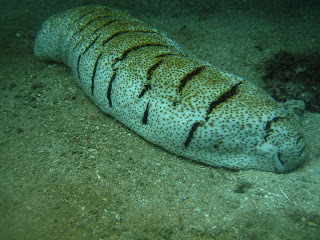Beche-de-mer Survey Madang Province
Below is the list of Sea cucumber species found in Madang Province during 2012 survey. The survey was funded by the National Fisheries Authority and carried out by the Fisheries Management Unit under Sedentary fisheries. Complete list of species of sea cucumber species found in Madang province:
Figure 1. Tiger Fish - Bohadschia argus
Figure 2. Deep Water Red Fish - Actinopyga echinata
Figure 3. Elephant trunkfish - Holothuria fuscopunctata
Table 2. Relative abundance of each sea cucumber species
recorded the reefs of Madang in 2010 – 2012 surveys.
Note:
Common names follow those used by the Secretariat of the Pacific Community
(2003).
Species Common Name
Holothuria atra
|
Lollyfish
|
Pearsonothuria graeffei
|
Flowerfish
|
Bohadschia argus
|
Tigerfish
|
Thelenota anax
|
Amberfish
|
Holothuria edulis
|
Pinkfish
|
Thelenota ananas
|
Prickly Redfish
|
Holothuria scabra
|
Sand fish
|
Stichopus herrmanni
|
Curryfish
|
Holothuria fuscopunctata
|
Elephant trunkfish
|
Stichopus chloronotus
|
Greenfish
|
Actinopyga lecanora
|
Stonefish
|
Holothuria fuscogilva
|
White Teatfish
|
Holothuria nobilis
|
Black Teatfish
|
Actinopyga miliaris
|
Blackfish
|
Bohadschia vitiensis
|
Brown sandfish
|
Actinopyga echinites
|
Deepwater redfish
|
Holothuria coluber
|
Snakefish
|
Actinopyga mauritiana
|
Surf redfish
|






